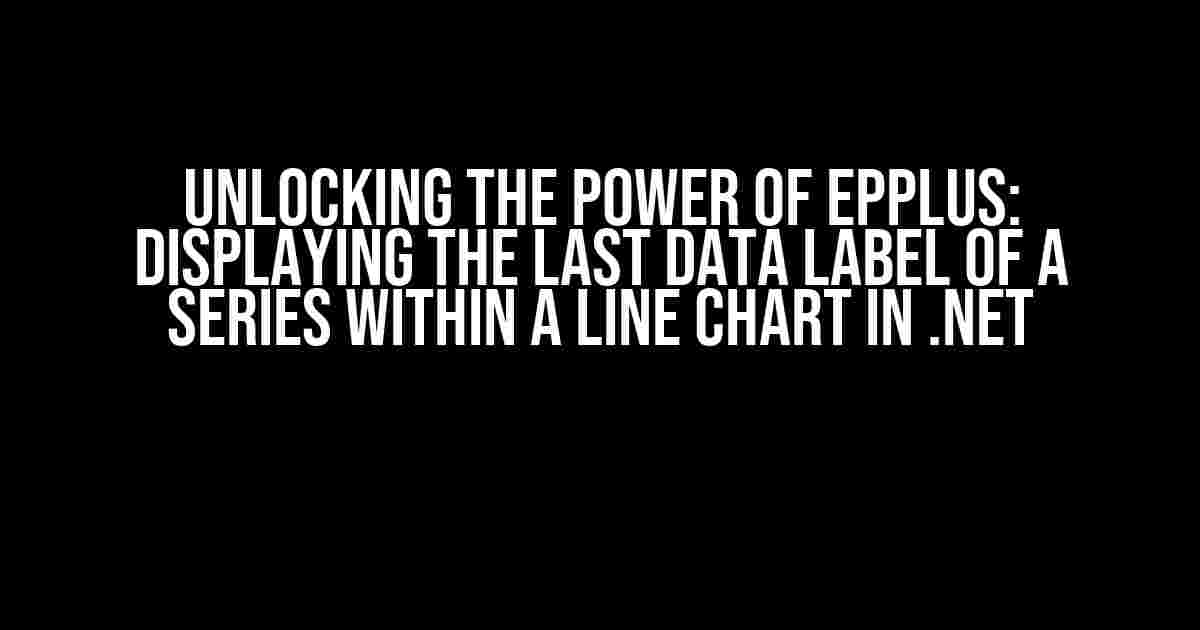As a .NET developer working with EPPlus, you’re likely no stranger to creating stunning charts and graphs that bring your data to life. But have you ever wondered how to display the last data label of a series within a line chart? In this article, we’ll dive into the world of EPPlus and explore the step-by-step process of achieving this impressive feat. Buckle up, folks, and get ready to take your charting skills to the next level!
What You’ll Need
- .NET Framework 4.5 or later
- EPPlus library (latest version)
- A sample Excel file (we’ll create one in this tutorial)
- A basic understanding of C# and EPPlus
Step 1: Setting Up the Stage
Before we begin, let’s create a new C# project in Visual Studio and add the EPPlus library via NuGet. You can do this by right-clicking your project, selecting “Manage NuGet Packages,” and searching for EPPlus.
using OfficeOpenXml;
using OfficeOpenXml.Drawing;
using OfficeOpenXml.Drawing.Chart;Now, let’s create a sample Excel file with some dummy data to work with. Create a new Excel file named “SampleData.xlsx” and add the following data:
| Month | Sales |
|---|---|
| January | 100 |
| February | 120 |
| March | 110 |
| April | 130 |
| May | 140 |
Step 2: Creating the Line Chart
Now that we have our sample data, let’s create a line chart using EPPlus. In your C# project, add the following code:
using (var package = new ExcelPackage(new FileInfo("SampleData.xlsx")))
{
ExcelWorksheet worksheet = package.Workbook.Worksheets[1];
ExcelChart chart = worksheet.Drawings.AddChart("Chart1", eChartType.Line);
chart.Title.Text = "Sales Chart";
chart.XAxis.Title.Text = "Month";
chart.YAxis.Title.Text = "Sales";
var series = chart.Series.Add("Sales", "A1:B6");
series.HeaderAddress = new ExcelAddress("A1");
series.DataLabels.ShowValue = true;
worksheet.Select("A1:B6");
chart.Legend.Remove();
package.Save();
}This code creates a line chart with the title “Sales Chart” and adds a series based on the data in cells A1:B6. We’ve also set the data labels to display the values.
Step 3: Finding the Last Data Label
Now that we have our chart, let’s focus on finding the last data label of the series. We can do this by accessing the `DataLabels` collection of the series and iterating through it:
var lastDataLabel = series.DataLabels.LastOrDefault();
In this code, we’re using the `LastOrDefault` method to find the last data label in the collection. If the collection is empty, this will return `null`.
Step 4: Displaying the Last Data Label
Now that we have the last data label, let’s display it within the chart. We can do this by adding a new `DataLabel` and setting its `Text` property to the value of the last data label:
var lastDataLabelValue = lastDataLabel?.Text;
if (lastDataLabelValue != null)
{
var lastDataPoint = series.DataPoints.LastOrDefault();
if (lastDataPoint != null)
{
var newText = new DataLabel { Text = $"Last: {lastDataLabelValue}" };
lastDataPoint.DataLabels.Add(newText);
}
}
In this code, we’re checking if the last data label is not null and then adding a new `DataLabel` with the text “Last: [value]” to the last data point.
Final Touches
Let’s add some final touches to our chart. We can add a title to the chart, change the chart type, or add more series. The possibilities are endless!
chart.ChartType = eChartType.LineMarkers;
chart.Title.Text = "Sales Chart with Last Data Label";
Conclusion
And that’s it! We’ve successfully displayed the last data label of a series within a line chart using EPPlus in .NET. With these steps, you can now take your charting skills to the next level and create stunning visualizations that showcase your data in the best possible way.
Remember, the key to mastering EPPlus is to experiment and explore its vast range of features. Don’t be afraid to try new things and push the limits of what’s possible.
Happy charting, and see you in the next article!
Additional Resources
Optimized for the keyword “How can I display the last data label of a series within a line chart in .net with Epplus?” this article provides a comprehensive guide to achieving this task using EPPlus in .NET. With clear instructions and explanations, this article is perfect for developers looking to take their charting skills to the next level.Here is the FAQ in the requested format:
Frequently Asked Question
Get the answers to your most burning questions about displaying the last data label of a series within a line chart in .NET with EPPlus!
What is the basic idea to display the last data label of a series within a line chart in .NET with EPPlus?
The basic idea is to loop through the data points in the series and set the `IsValueShown` property to `true` only for the last data point. You can do this by using the `ChartSeries.DataLabel` property and iterating over the `DataLabelCollection`.
How do I access the data points in the series?
You can access the data points in the series by using the `ChartSeries.DataPointCollection` property. This property returns a collection of `DataPoint` objects, which you can then loop through to set the `IsValueShown` property.
What if I want to display the last data label with a specific format?
You can format the last data label by setting the `NumberFormat` property of the `DataLabel` object. For example, you can set it to “0.00” to display the value with two decimal places.
Can I use this approach with other types of charts?
Yes, this approach can be used with other types of charts, such as column charts and bar charts, as long as they support data labels. Just make sure to adjust the code to fit the specific chart type and requirements.
Are there any performance considerations I should be aware of?
Yes, if you have a large dataset, iterating over the data points in the series can impact performance. To mitigate this, consider using a more efficient approach, such as using LINQ to filter the data points, or optimizing your chart data to reduce the number of data points.


